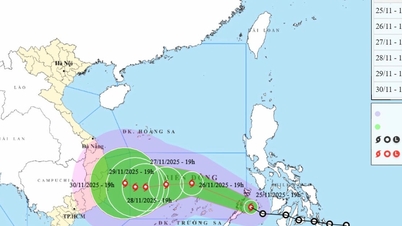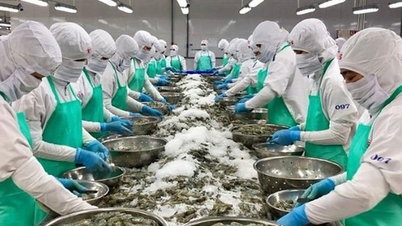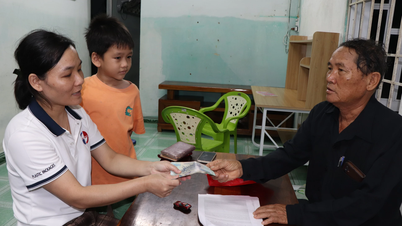
Photo: Getty Images
According to Sputnik, with an increase of 8.23% over the same period last year, Vietnam leads the ASEAN-6 group and achieves a growth rate nearly 7 times higher than Thailand - a country that recorded an increase of only 1.2% and is facing a prolonged decline.
Many ASEAN economies are slowing down, Vietnam is different
The regional picture shows that four of Southeast Asia's six largest economies saw growth slow in the third quarter.
Among the two countries that maintained an improving trend, Vietnam and Malaysia, Vietnam clearly stood out with the fastest growth rate, affirming its role as a bright spot in the context of many regional economies being pressured by weakening global trade, slowing investment and slowing domestic consumption.
Specifically, in the third quarter of 2025, Vietnam will become the economy with the highest GDP growth rate in ASEAN-6, reaching 8.23% over the same period last year.
This is not only a remarkable increase in the region, but also the second highest quarterly increase in Vietnam in the entire 2011-2025 period, only behind the 14.38% increase in the third quarter of 2022 - the period when the economy made a strong breakthrough thanks to full reopening after the pandemic.
In the first nine months of the year, Vietnam's GDP increased by 7.85%, continuing to maintain a high growth trajectory and only lower than the 9.44% level of 2022. This reflects the ability to recover sustainably, in the context of many regional economies facing a significant slowdown.
Vietnam's growth in the third quarter was supported by all three sectors. Agriculture, forestry and fishery increased by 3.83%, showing a stable food supply base, less affected by climate fluctuations and world agricultural prices.
Industry and construction increased sharply by 8.69%, becoming an important growth driver of the economy. Notably, the processing and manufacturing industry increased by nearly 10%, continuing to be a pillar in the context of recovering electronics exports and FDI factories increasing capacity.
The service sector grew by 8.49%, contributing more than half of the overall growth, reflecting a clear improvement in domestic consumption, trade, logistics and tourism -transportation related services. With all three sectors expanding, Vietnam’s growth structure shows a rare balance compared to economies that are still heavily dependent on one or two main drivers.
Thanks to the growth results exceeding expectations, international confidence in Vietnam is increasingly strengthened. A series of major financial institutions such as Standard Chartered, HSBC, UOB and ADB have simultaneously raised Vietnam's 2025 growth forecast from 1 to 1.5 percentage points. Standard Chartered raised it from 6.1% to 7.5%, HSBC adjusted it from 6.6% to 7.9%, UOB raised it from 7.5% to 7.7%, and ADB forecast 6.7%.
The fact that international institutions have made strong adjustments in the context of a weakening global economy, shrinking world trade and unstable interest rate cycles shows that they highly appreciate Vietnam's internal resilience, especially the resilience of the domestic production and consumption sectors.
ASEAN countries' growth is clearly differentiated.
In the broader ASEAN-6 picture, growth divergence is evident, with Malaysia, the country behind Vietnam, posting a 5.2% growth in the third quarter, beating most market forecasts.
Malaysia’s growth is largely driven by resilient domestic demand and a strong labor market, while exports have only recently recovered slightly. However, the 2025 outlook for Malaysia has been revised cautiously to around 4–4.8%, due to concerns about a slowdown in global trade.
Indonesia maintained a steady growth rate of 5.04%, slightly higher than the 4.95% recorded in the second quarter. This was the result of an expansion in production, along with improvements in government spending and exports. In the first nine months of the year, the 5.01% growth was in line with Jakarta's 5% target. Compared to other Southeast Asian countries, Indonesia benefits from a large market size and a growing mineral processing industry, but the growth rate has mainly hovered around the 5% threshold in recent years.
In contrast, the Philippines saw growth slow sharply to 4%, well below forecasts and down from 5.5% in the previous quarter. The slowdown was largely due to weaker household consumption, slower investment and lower government spending. The economic pressures facing the Philippines reflect its heavy reliance on domestic consumption, making growth vulnerable to high inflation and rising living costs.
Singapore has not been immune to the global slowdown. Growth slowed to 2.9% in the third quarter, down from 4.5% in the second quarter. The island nation’s manufacturing sector has been hit hard by US reciprocal tariffs and a slowdown in global trade. However, thanks to steady growth in the services, retail and transport sectors, Singapore has managed to keep the slowdown in check and avoid falling into a growth slump.
Thailand was the weakest case in ASEAN-6, with GDP growing just 1.2% – the weakest since 2021. Manufacturing activity contracted 1.6%, marking the first quarterly contraction after six consecutive quarters of expansion, with sharp declines in the automotive, machinery and rubber products sectors. Exports of goods and services grew 6.9%, but still well below the 11.2% growth in the second quarter due to slowing growth in computers and tourism. NESDC forecasts Thailand’s growth to be just 2% in 2025 and between 1.2% and 2.2% in 2026, reflecting structural difficulties the economy has yet to overcome.
Sputnik commented: The strong differentiation in the third quarter of 2025 has highlighted Vietnam's position in the region. While the four major economies of Singapore, Indonesia, the Philippines and Thailand all slowed down and Thailand fell into a clear downward spiral, Vietnam and Malaysia became two rare cases of improved growth.
Most notably, Vietnam's growth rate is nearly 7 times higher than Thailand's and nearly 3 times higher than Singapore's, showing that Vietnam is emerging as the most resilient economy in ASEAN-6 in a context where the region is facing many risks and fluctuations.
Source: https://baochinhphu.vn/sputnik-gdp-viet-nam-cao-gap-gan-7-lan-thai-lan-bao-xa-nhieu-nuoc-lang-gieng-10225112310444528.htm




![[Photo] Close-up of Ba Ha River Hydropower Plant operating to regulate water to downstream](/_next/image?url=https%3A%2F%2Fvphoto.vietnam.vn%2Fthumb%2F1200x675%2Fvietnam%2Fresource%2FIMAGE%2F2025%2F11%2F25%2F1764059721084_image-6486-jpg.webp&w=3840&q=75)

![[Photo] Prime Minister Pham Minh Chinh receives Governor of Gunma Prefecture (Japan) and Special Advisor to the Japan-Vietnam Friendship Parliamentary Alliance](/_next/image?url=https%3A%2F%2Fvphoto.vietnam.vn%2Fthumb%2F1200x675%2Fvietnam%2Fresource%2FIMAGE%2F2025%2F11%2F25%2F1764066321008_dsc-1312-jpg.webp&w=3840&q=75)














































![[Answer] Should I install an elevator for an old renovated house?](https://vphoto.vietnam.vn/thumb/402x226/vietnam/resource/IMAGE/2025/11/25/1764039191595_co-nen-lap-thang-may-cho-nha-cai-tao-cu-khong-04.jpeg)















































Comment (0)